Leaf Fluxes of Carbon Dioxide, Methane and Biogenic Volatile Organic Compounds of the Urban Trees Platanus × acerifolia and Schinus molle in Santiago, Chile
Abstract
:1. Introduction
2. Materials and Methods
2.1. Study Site and Sampling
2.1.1. CO2 and CH4 Fluxes
2.1.2. BVOCs Sampling
2.2. BVOC Chemical Analysis
2.3. Emission Factor (EF) and Potential Ozone Forming Index (POCI)
3. Results and Discussion
3.1. Emission Factor of Terpenes
3.2. Mean and Total EF and Photochemical Ozone Creation Index, POCI
3.3. Methane and CO2 Fluxes
4. Conclusions
Supplementary Materials
Author Contributions
Funding
Data Availability Statement
Acknowledgments
Conflicts of Interest
References
- Tyrväinen, L.; Pauleit, S.; Seeland, K.; de Vries, S. Benefits and Uses of Urban Forests and Trees. In Urban Forests and Trees; Konijnendijk, C., Nilsson, K., Randrup, T., Schipperijn, J., Eds.; Springer: Berlin/Heidelberg, Germany, 2005; pp. 81–144. [Google Scholar]
- Huang, C.; Chen, C.; Li, L.; Cheng, Z.; Wang, H.; Huang, H.; Cheng, Y.; Streets, D.G.; Wang, Y.J.; Zhang, G.F.; et al. Emission inventory of anthropogenic air pollutants and VOC species in the Yangtze River Delta region, China. Atmos. Chem. Phys. 2011, 11, 4105–4120. [Google Scholar] [CrossRef] [Green Version]
- Loreto, F.; Schnitzler, J.P. Abiotic stresses and induced BVOCs. Trends Plant Sci. 2010, 15, 154–166. [Google Scholar] [CrossRef] [PubMed]
- Seinfeld, J.; Pandis, S. Chemistry of the Troposphere. In Atmospheric Chemistry and Physics: From Air Pollution to Climate Change; Seinfeld, J.H., Pandis, S.N., Eds.; John Wiley & Sons: Hoboken, NJ, USA, 2016; pp. 208–211. [Google Scholar]
- Forester, C.; Wells, J. Hydroxyl radical yields from reactions of terpene mixtures with. Indoor Air 2011, 21, 400–409. [Google Scholar] [CrossRef] [PubMed]
- Jerrett, M.; Burnett, R.; Pope, C.; Ito, K.; Thurston, G.; Krewski, D.; Shi, Y.; Calle, E.; Thun, M. Long-Term Ozone Exposure and Mortality. N. Engl. J. Med. 2009, 360, 1085–1095. [Google Scholar] [CrossRef] [PubMed] [Green Version]
- Jurán, S.; Grace, J.; Urban, O. Temporal Changes in Ozone Concentrations and Their Impact on Vegetation. Atmosphere 2021, 12, 82. [Google Scholar] [CrossRef]
- Pellegrini, E.; Hoshika, Y.; Dusart, N.; Cotrozzi, L.; Gérard, J.; Nali, C.; Vaultier, M.-N.; Jolivet, Y.; Lorenzini, G.; Paoletti, E. Antioxidative responses of three oak species under ozone and water stress conditions. Sci. Total Environ. 2019, 647, 390–399. [Google Scholar] [CrossRef]
- Elshorbany, Y.; Kleffmann, J.; Kurtenbach, R.; Rubio, M.; Lissi, E.; Villena, G.; Gramash, E.; Rickard, A.; Pilling, M.J.; Wiesen, P. Summertime photochemical ozone formation in Santiago, Chile. Atmos. Environ. 2009, 43, 6398–6407. [Google Scholar] [CrossRef]
- Préndez, M.; Araya, M.; Criollo, C.; Egas, C.; Farías, I.; Fuentealba, R.; González, E. Urban trees and its relationships with air pollution by particulate matter and ozone in Santiago de Chile. In Urban Climate in Latin-American Cities; Henríquez, C., Romero, H., Eds.; Springer International Publishing: Cham, Switzerland, 2019; pp. 167–206. [Google Scholar]
- SINCA. Sistema de Información Nacional de Calidad del Aire. Available online: https://sinca.mma.gob.cl/index.php/pagina/index/id/glosario (accessed on 15 July 2015).
- Seguel, R.J.; Gallardo, L.; Fleming, Z.; Landeros, S. Two decades of ozone standard exceedances in Santiago de Chile. Air Qual. Atmos. Health 2020, 13, 593–605. [Google Scholar] [CrossRef]
- Gramsch, E.; López, G.; Gidhagen, L. Estudio “Actualización y Sistematización del Inventario de Emisiones de Contaminantes Atmosféricos en la Región Metropolitana”; Departamento de Física, Universidad de Santiago de Chile: Santiago, Chile, 2014; Available online: https://sustempo.com/website/wp-content/uploads/2015/07/Inventario-deemisiones-RM_USACH_2014.pdf (accessed on 1 January 2022).
- Simon, V.; Dumergues, L.; Solignac, G.; Torres, L. Biogenic emissions from Pinus halepensis: A typical species of the Mediterranean area. Atmos. Res. 2005, 74, 37–48. [Google Scholar] [CrossRef]
- Padhy, P.; Varshney, C. Isoprene emission from tropical tree species. Environ. Pollut. 2005, 135, 101–109. [Google Scholar] [CrossRef]
- Moukhtar, S.; Couret, C.; Rouil, L.; Simon, V. Biogenic Volatile Organic Compounds (BVOCs) emissions from Abies alba in a French forest. Sci. Total Environ. 2006, 354, 232–245. [Google Scholar] [CrossRef] [PubMed]
- Préndez, M.; Carvajal, V.; Corada, K.; Morales, J.; Alarcón, F.; Peralta, H. Biogenic volatile organic compounds from the urban forest of the Metropolitan Region, Chile. Environ. Pollut. 2013, 183, 143–150. [Google Scholar] [CrossRef] [PubMed]
- Ehsan, K.; Anoushirvan, S.; Mohammad, A.; Thomas, S. In situ emission of BVOCs by three urban woody species. Urban For. Urban Green. 2017, 21, 153–157. [Google Scholar]
- Yaman, B.; Aydin, Y.; Koca, H.; Dasdemir, O.; Kara, M.; Altiok, H.; Dumanoglu, Y.; Bayram, A.; Tolunay, D.; Odabasi, M.; et al. Biogenic Volatile Organic Compound (BVOC) Emissions from Various Endemic Tree Species in Turkey. Aerosol Air Qual. Res. 2015, 15, 341–356. [Google Scholar] [CrossRef] [Green Version]
- Guenther, A.; Zimmerman, P.; Harley, P.; Monson, R.; Fall, R. Isoprene and monoterpene emission rate variability: Model evaluations and sensitivity analyses. J. Geophys. Res. Atmos. 1993, 98, 12609–12617. [Google Scholar] [CrossRef] [Green Version]
- Derwent, R.; Jenkin, M.; Passant, N.; Pilling, M. Photochemical ozone creation potentials (POCPs) for different emission sources of organic compounds under European conditions estimated with a Master Chemical Mechanism. Atmos. Environ. 2007, 41, 2570–2579. [Google Scholar] [CrossRef]
- Scholz, L.L.G. Estimation of the Potential BVOC Emissions by the Different Tree Species in Malmö. Bachelor’s Thesis, Lund University, Lund, Sweden, 2019. Series INES. Available online: https://lup.lub.lu.se/student-papers/search/publication/8986300 (accessed on 1 January 2022).
- Aydin, Y.; Yaman, B.; Koca, H.; Dasmedir, O.; Kara, M.; Altiok, H.; Elbir, T. Biogenic volatile organic compoundas (BVOC) emissions from forested areas in Turkey: Determination of specific emission rates for thirty-one tree species. Sci. Total Environ. 2014, 490, 239–253. [Google Scholar] [CrossRef]
- Jing, X.; Lun, X.; Fan, C.; Ma, W. Emission patterns of biogenic volatile organic compounds from dominant forest species in Beijing, China. J. Environ. Sci. 2020, 95, 73–81. [Google Scholar] [CrossRef]
- Préndez, M.; Corada, K.; Morales, J. Emission factors of biogenic volatile organic compounds in various stages of growth present in the urban forest of the Metropolitan Region, Chile. Res. J. Chem. Environ. 2013, 17, 108–116. [Google Scholar]
- Terazawa, K.; Ishizuka, S.; Sakata, T.; Yamada, K.; Takahashi, M. Methane emissions from stems of Fraxinus mandshurica var. japonica trees in a floodplain forest. Soil Biol. Biochem. 2007, 39, 2689–2692. [Google Scholar] [CrossRef]
- Gauci, V.; Gowing, D.; Hornibrook, E.; Davis, J.; Dise, N. Woody stem methane emission in mature wetland alder trees. Atmos. Environ. 2010, 44, 2157–2160. [Google Scholar] [CrossRef] [Green Version]
- Diaz, M.; Bown, H.; Fuentes, J.; Martinez, A. Soils act as sinks or sources of CH4 depending on air-filled porosity in sclerophyllous ecosystems in semiarid central Chile. Appl. Soil Ecol. 2018, 130, 13–20. [Google Scholar] [CrossRef]
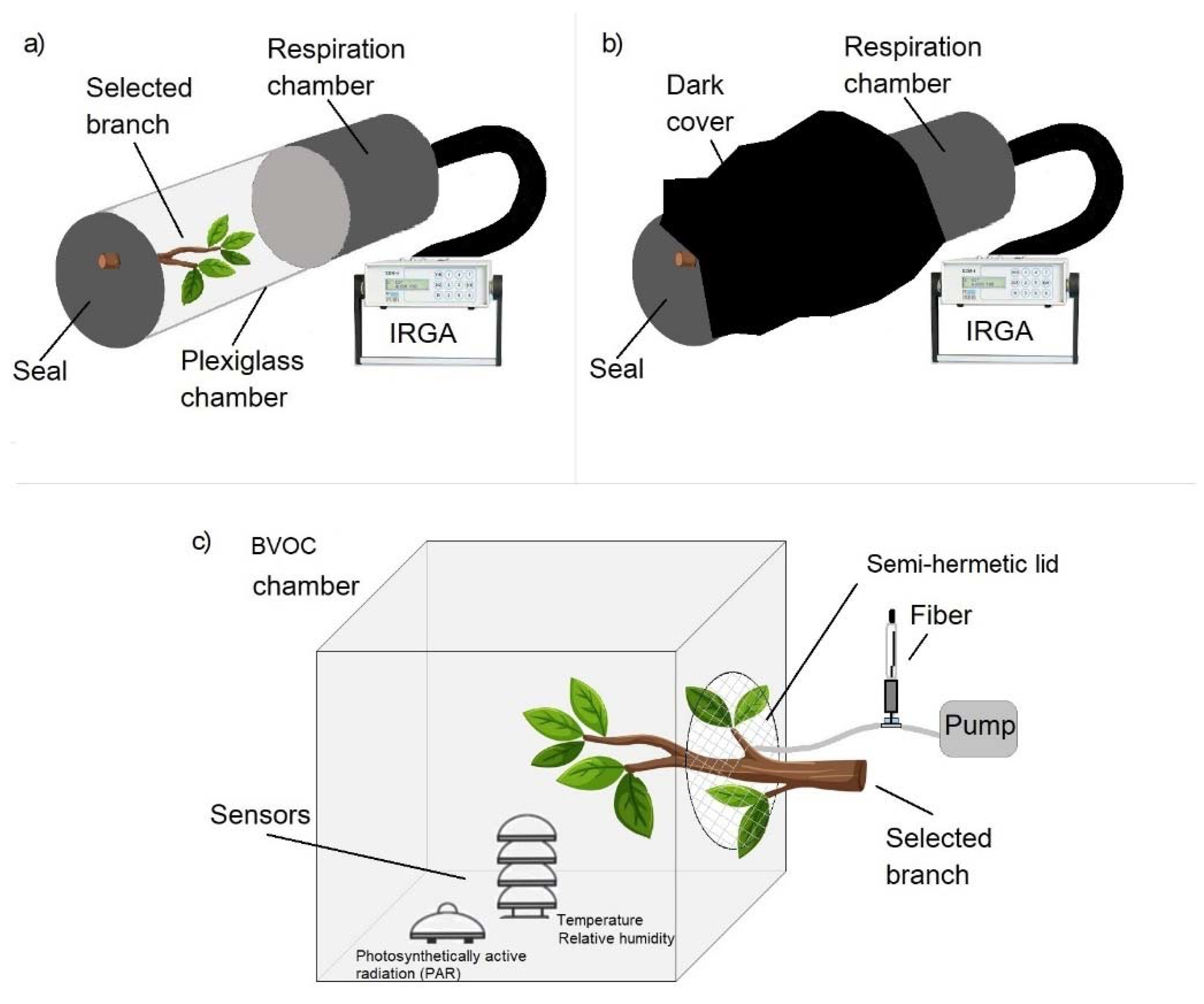
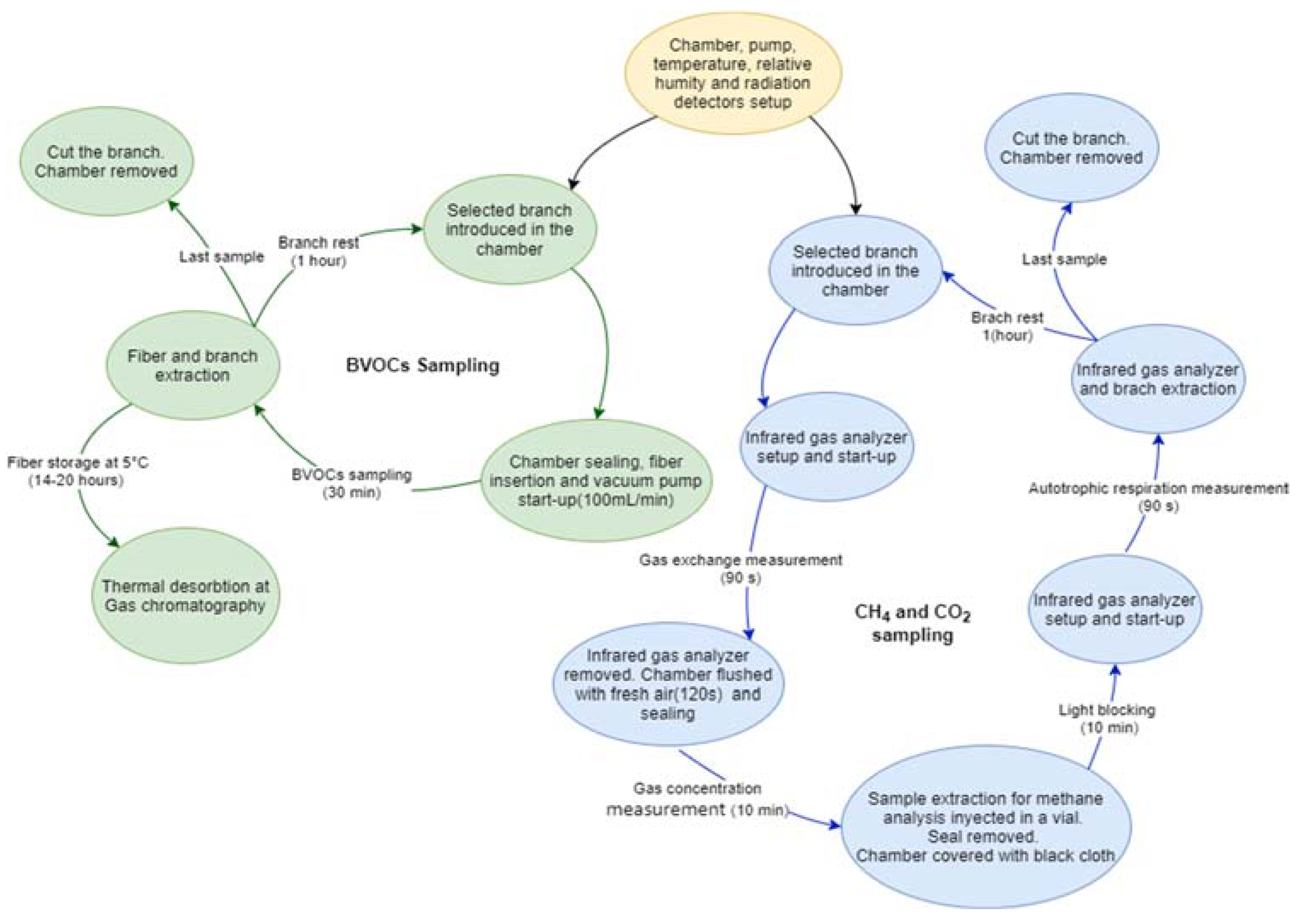
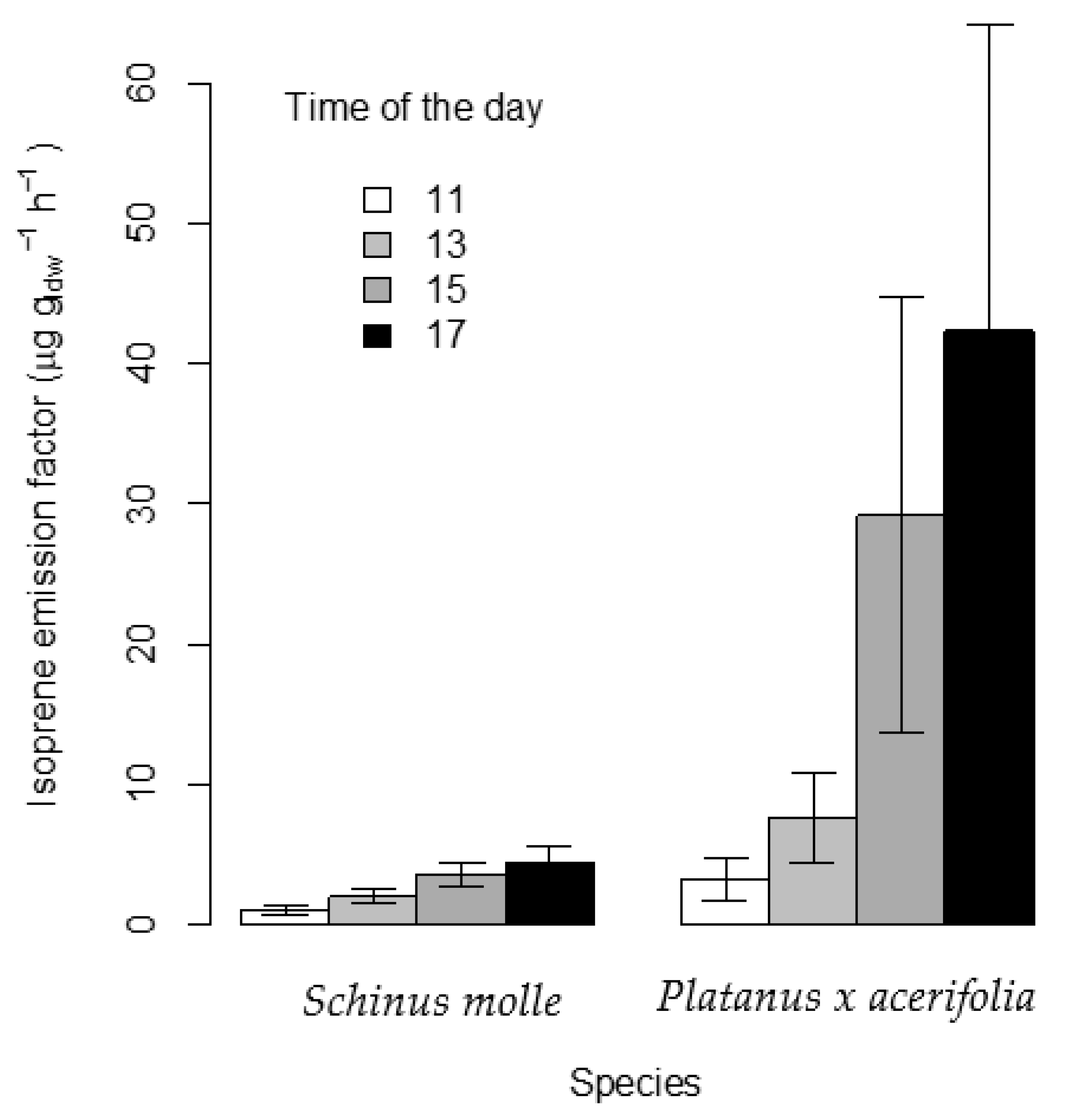
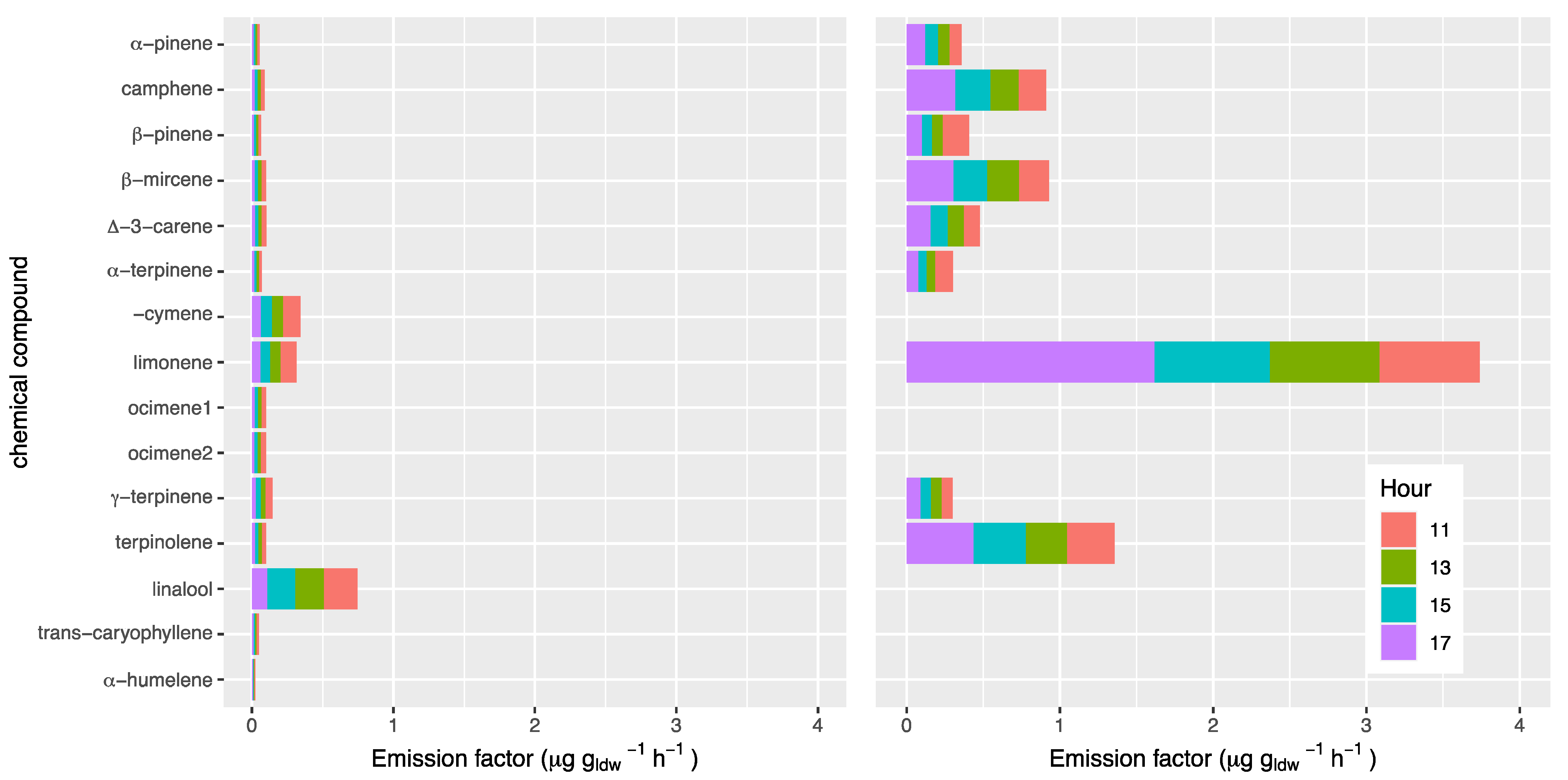
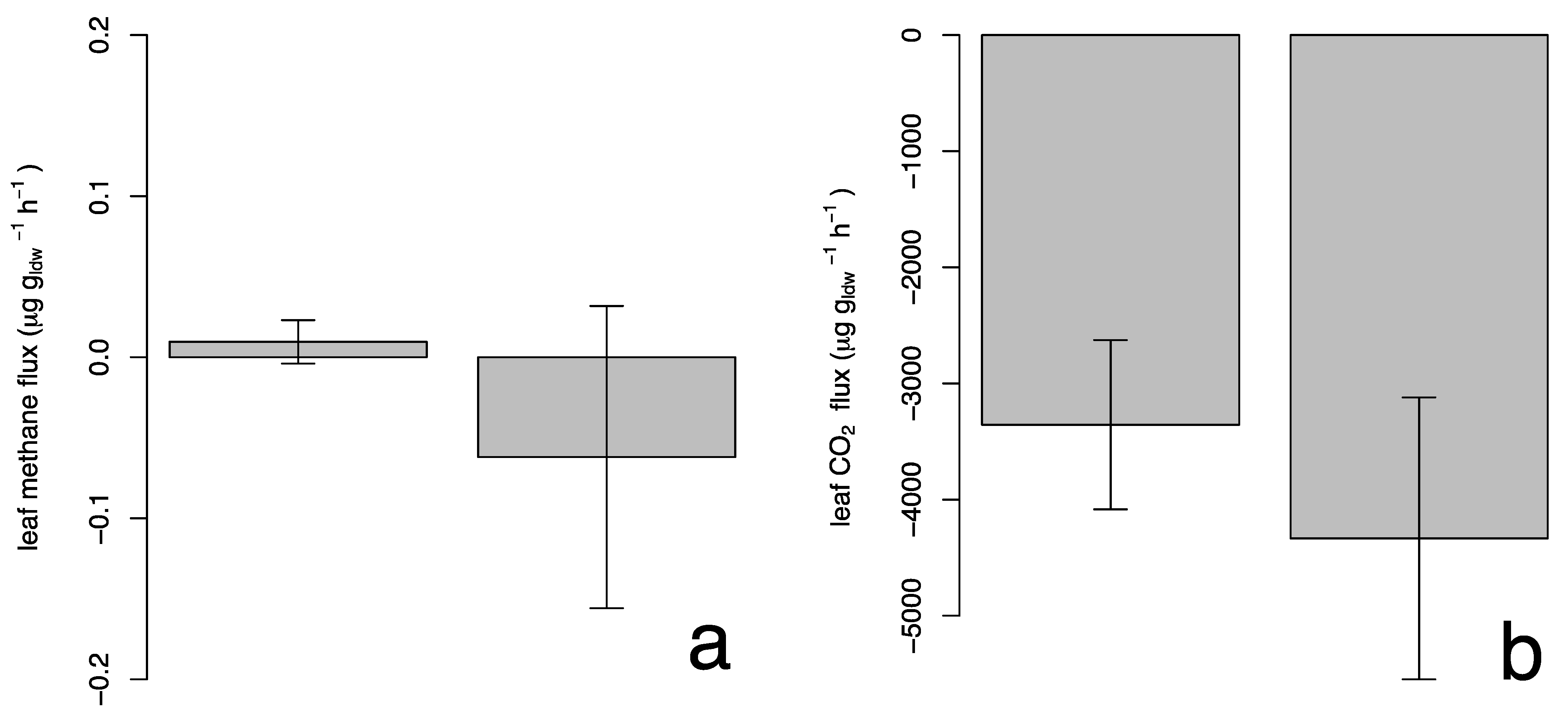
| Compound | Platanus × acerifolia | Schinus molle | ||||||
|---|---|---|---|---|---|---|---|---|
| Mean EF | SD-EF (n = 20) | POCI | C Flux | Mean EF | SD-EF (n = 20) | POCI | C Flux | |
| Isoprene | 20.6 | 18.40 | 2351 | 18.20 | 2.70 | 1.50 | 315 | 2.40 |
| α-Pinene | 0.0026 | 0.0005 | 0.18 | 0.000 | 0.0180 | 0.0040 | 1.20 | 0.016 |
| Camphene | 0.0045 | 0.0010 | 0.03 | 0.0040 | 0.0460 | 0.0120 | 0.30 | 0.040 |
| β-Pinene | 0.0032 | 0.0006 | 0.23 | 0.0028 | 0.0200 | 0.0100 | 2.30 | 0.018 |
| β-Myrcene | 0.005 | 0.0014 | - | 0.0044 | 0.0460 | 0.0097 | - | 0.041 |
| Δ-3-carene | 0.0051 | 0.0012 | 0.12 | 0.0045 | 0.0240 | 0.0047 | 0.60 | 0.021 |
| α-terpinene | 0.0034 | 0.0006 | 0.52 | 0.0031 | 0.0150 | 0.0058 | 2.30 | 0.013 |
| p-Cymene | 0.017 | 0.0054 | - | 0.0150 | - | - | - | - |
| Limonene | 0.015 | 0.0048 | 1.10 | 0.0140 | 0.1900 | 0.0910 | 13.20 | 0.160 |
| Ocimene1 | 0.0049 | 0.0011 | - | 0.0044 | - | - | - | - |
| Ocimene2 | 0.0049 | 0.0016 | - | 0.0043 | - | - | - | - |
| γ-terpinene | 0.0073 | 0.0021 | 1.10 | 0.0064 | 0.0150 | 0.0021 | 2.00 | 0.013 |
| Terpinolene | 0.0049 | 0.0008 | 0.35 | 0.0043 | 0.0680 | 0.0140 | 4.90 | 0.060 |
| Linalool | 0.037 | 0.0110 | 3.70 | 0.0290 | - | - | - | |
| Trans-Caryophyllene | 0.0024 | 0.0005 | 0.35 | 0.0021 | - | - | - | - |
| α-humulene | 0.0012 | 0.0003 | 0.18 | 0.0011 | - | - | - | - |
| Total emissions VOCs | 20.72 | - | 2359 | 18.30 | 3.14 | - | 342 | 2.78 |
| Carbon Uptake (Photosynthesis) | - | −915 | - | - | - | −1156 | ||
| Net carbon flux | - | - | - | −896 | - | - | - | −1153 |
Publisher’s Note: MDPI stays neutral with regard to jurisdictional claims in published maps and institutional affiliations. |
© 2022 by the authors. Licensee MDPI, Basel, Switzerland. This article is an open access article distributed under the terms and conditions of the Creative Commons Attribution (CC BY) license (https://creativecommons.org/licenses/by/4.0/).
Share and Cite
Farías, I.; Préndez, M.; Bown, H.E. Leaf Fluxes of Carbon Dioxide, Methane and Biogenic Volatile Organic Compounds of the Urban Trees Platanus × acerifolia and Schinus molle in Santiago, Chile. Atmosphere 2022, 13, 298. https://doi.org/10.3390/atmos13020298
Farías I, Préndez M, Bown HE. Leaf Fluxes of Carbon Dioxide, Methane and Biogenic Volatile Organic Compounds of the Urban Trees Platanus × acerifolia and Schinus molle in Santiago, Chile. Atmosphere. 2022; 13(2):298. https://doi.org/10.3390/atmos13020298
Chicago/Turabian StyleFarías, Iván, Margarita Préndez, and Horacio E. Bown. 2022. "Leaf Fluxes of Carbon Dioxide, Methane and Biogenic Volatile Organic Compounds of the Urban Trees Platanus × acerifolia and Schinus molle in Santiago, Chile" Atmosphere 13, no. 2: 298. https://doi.org/10.3390/atmos13020298
APA StyleFarías, I., Préndez, M., & Bown, H. E. (2022). Leaf Fluxes of Carbon Dioxide, Methane and Biogenic Volatile Organic Compounds of the Urban Trees Platanus × acerifolia and Schinus molle in Santiago, Chile. Atmosphere, 13(2), 298. https://doi.org/10.3390/atmos13020298






